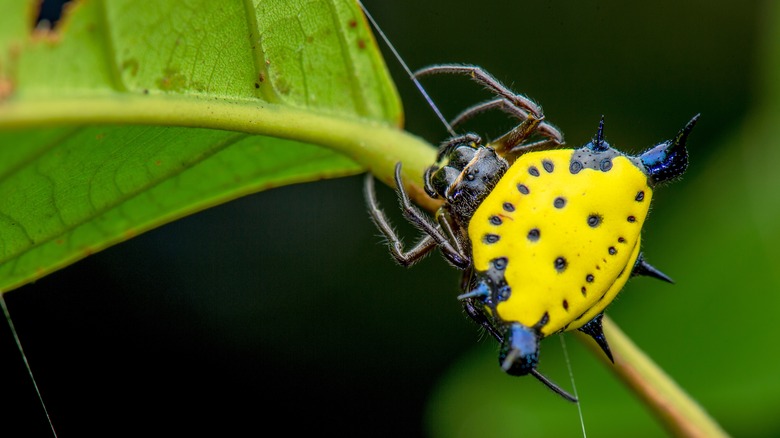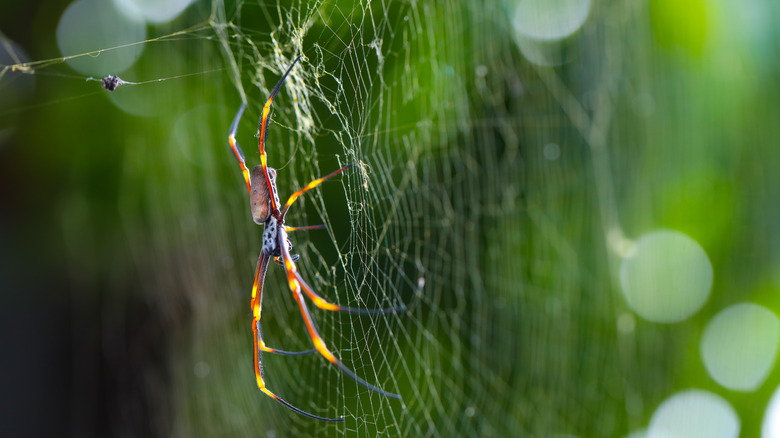Which Type Of Orb Weaver Spider Is Lurking In Your Garden?
Welcome to the fascinating world of orb weaver spiders. Knowing about the different types of orb weaver spiders that may inhabit your green haven is crucial for a variety of reasons. Firstly, it allows you to appreciate the biodiversity within your own backyard. Secondly, recognizing these spiders enhances your garden experience by helping you distinguish harmless weavers from potentially harmful species. However, if any kind of arachnid creeps you out, or if you're allergic or sensitive to spider bites or spiders in general, even beneficial orb weavers may prove undesirable in your garden. Either way, it would be good to know what orb weavers are, how they look, and the more common varieties you may find residing in your green oasis.
Orb weaver spiders typically have a bright-colored body, a rounded, bulging abdomen, and prominent spines on their legs. What truly sets them apart, though, is their remarkable orb-shaped webs. These silk marvels are meticulously crafted to capture unsuspecting prey, showcasing the spider's exceptional skills in both silk production and web design. These spiders are not aggressive and don't pose a significant threat to humans. In fact, they are more focused on building and maintaining their webs to catch prey, such as flying bugs or insects. They're not known to bite humans unless they feel threatened or cornered, and even then, their bites are typically mild and rarely cause serious reactions.
Here, we'll explore common orb weaver spider varieties found in gardens, highlighting their distinct characteristics.
Spotted orb weaver
Our first spotlight is on Neoscona crucifera, commonly known as the spotted orb weaver. Known for their distinctive markings and valuable role in pest control, these spiders are prevalent in gardens throughout North America. Both male and female spotted orb weavers are easily distinguishable by their typically rusty red or orange bodies, a distinct white cross pattern on their abdomens, and alternating light and dark brown stripes on their legs. With an average size of about ¾ of an inch to 1½ inches for females (and slightly smaller males), they are relatively small, making them more intriguing than threatening.
Known for being masterful architects, their webs are typically suspended between plants. These arachnids often rest head-down in the center, awaiting prey to become ensnared. Spotted orb weaver spiders play a vital role in controlling insect populations in your garden, making them valuable garden allies to the green-thumbed community. Neoscona crucifera is harmless to humans. While their webs might seem intricate and imposing, these spiders, like other orb weavers, are not aggressive and will generally retreat when approached.
Spiny-backed orb weaver
Next in our exploration is the spiny or spiny-backed orb weaver (Gasteracantha cancriformis). With a body length reaching ½-inch at most, this tiny and unique garden guardian is a sight to behold. Both females and slightly smaller males display vibrant colors and intricate patterns, with six distinct spines protruding from their abdomen. Frequently found in gardens across the Americas, spiny-backed orb weavers are known for their intricate webs decorated with silk stabilimenta, which are zigzag patterns that add both structural support and camouflage.
The spiny orb weaver — a formidable garden guardian (yet virtually harmless to humans) — is a skilled predator actively hunting for small insects at night. It preys on a variety of flying insects that become trapped in its meticulously spun web. This includes mosquitoes, flies, and other pests that can be troublesome in a garden. By controlling insect populations, the spiny orb weaver contributes to the overall health of the garden ecosystem.
Golden silk orb weaver
Trichonephila clavipes (aka Nephila clavipes, golden silk orb weaver, golden silk spider) is a species known for its stunning golden-hued silk. These spiders create large webs, often spanning a few feet between trees or structures. The spiders themselves, especially the females, are often large and can have a body length of over 1 inch. Their vibrant colors and conspicuous size make them stand out in the garden, creating a visual spectacle for observers.
The female golden silk orb weavers are recognizable by their striking yellow, orange or tan, and black patterns. Skilled hunters, golden silk orb weavers capture a variety of flying insects that become entangled in their robust webs, targeting moths, beetles, and other insects that might pose a threat to plants. Despite their intimidating appearance, these spiders are generally docile and prefer to run when disturbed rather than risk a confrontation. These orb weavers contribute not only to pest control but also add an aesthetic dimension to outdoor spaces. Remarkably, their silk possesses a golden tint, reflecting sunlight and making their webs appear like glistening jewelry.
Silver garden orb weaver
The Argiope argentata, commonly known as the silver garden orb weaver or silver argiope, is a distinctive, visually stunning orb-weaving spider species. The abdomen of the female spider is silver or silvery-white, and it often displays intricate patterns or markings. The male, in contrast, is much smaller and has a more subdued coloration, usually brown or gray.
Like other orb weavers, the silver garden orb weaver constructs large, circular webs with a distinctive zigzag stabilimentum at the center. The silver garden orb weaver is known for its preference for warm and sunny locations, so is most often found in humid locations like Central and South America, the Southern United States, and the Caribbean. Primarily focused on capturing prey for sustenance, these orb weavers strategically place their webs to attract flying insects, including moths, mosquitoes, flies, and other small insects. Its venom is not harmful to humans, causing only slight swelling if bitten.
Cross orb weaver
Araneus diadematus, commonly known as the cross orb weaver, is characterized by a cross-shaped pattern on its abdomen. Cross orb weavers are efficient hunters, strategically positioning themselves in the center of their large, vertical webs, waiting for prey to become entangled. As with most other spiders, the females are larger than the males. The coloration for both sexes can vary from pale yellow to grey, providing some flexibility in adapting to different environments.
Mosquitoes, flies, and other small insects are common targets. The spider's hunting technique involves swiftly immobilizing its prey with silk before delivering a venomous bite. This method ensures a secure meal for the spider. Cross orb weavers, like others of their kind, are generally harmless to humans and prefer to retreat when disturbed. Getting bitten by one is comparable to experiencing a tiny pinch.
While orb weaver spiders are generally harmless and beneficial to the ecosystem by controlling insect populations, there are occasions when some may want to get rid of them because of phobia, allergies, or sensitivity. If you decide to remove orb weaver spiders from your garden, it's essential to use gentle removal methods like carefully relocating the spider to a more ideal location. For your safety, wear gloves to prevent any accidental bites. Keep outdoor spaces well-maintained by regularly cleaning and removing debris to discourage spiders from building their webs and inhabiting the space. Of course, you may also consider hiring professional pest control experts for help with spider removal.





